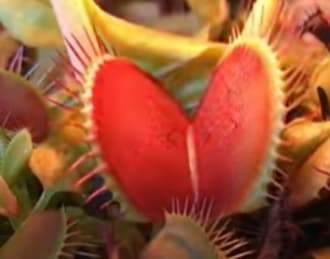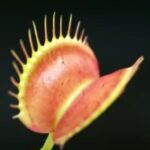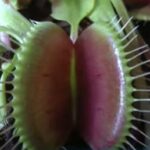As an Amazon Associate, this site earns commissions from qualifying purchases. For more details, click here.
Water gardens are serene sanctuaries that add an element of tranquility to any outdoor space. While commonly associated with aquatic plants like water lilies and lotuses, water gardens can also be an ideal habitat for unique and fascinating carnivorous plants such as Venus flytraps (Dionaea muscipula).
Key Takeaways:
- Venus flytraps thrive in shallow, well-draining containers with moist, acidic soil.
- Companion plants like pitcher plants and sundews enhance their water garden habitat.
- Regular maintenance, including monitoring water levels and pruning, ensures healthy growth and longevity
Venus flytraps are native to the boggy regions of North and South Carolina in the United States, where they thrive in acidic, nutrient-poor soils. They are renowned for their carnivorous nature, trapping insects with specialized leaves that snap shut when triggered. In their natural habitat, Venus flytraps grow in damp, nutrient-deficient soil, often submerged in shallow water or saturated boggy conditions.
Growing Venus Flytraps in Water Gardens
When incorporating Venus flytraps into your water garden, it’s essential to recreate their natural habitat as closely as possible. Follow these steps to ensure optimal growth and health:
Container Selection: Choose a shallow container or a water feature with a shallow basin to mimic the boggy conditions preferred by Venus flytraps. Ensure the container has drainage holes to prevent waterlogging.
Growing Medium: Venus flytraps thrive in a mix of sphagnum moss and perlite or sand. Fill the container with this well-draining mixture, ensuring it remains consistently moist but not waterlogged.
Water Requirements: Keep the water level in the container shallow, just enough to cover the roots of the Venus flytrap. Rainwater or distilled water is preferable, as tap water may contain minerals that can harm the plants over time.
Sunlight: Venus flytraps require ample sunlight to thrive. Place the container in a location where it will receive at least 6-8 hours of direct sunlight daily. If you’re growing them indoors, consider providing supplemental grow lights to ensure they receive adequate light.
Feeding: While Venus flytraps are capable of capturing insects on their own, supplementary feeding may be necessary, especially in nutrient-poor water garden environments. Avoid feeding them meat, as it can lead to rot. Look for live insects like small flies or ants, or use a diluted insectivorous plant fertilizer sparingly.

Companion Plants for Venus Flytraps
In addition to Venus flytraps, consider incorporating companion plants that complement their needs and enhance the aesthetic appeal of your water garden. Suitable companion plants include:
Pitcher Plants (Sarracenia spp.): Like Venus flytraps, pitcher plants are carnivorous and thrive in similar conditions. Their tall, trumpet-shaped pitchers add visual interest to the water garden while providing additional insect control.
Sundews (Drosera spp.): Sundews are another carnivorous plant species that trap insects with sticky tentacles. Their small, delicate foliage contrasts beautifully with the larger leaves of Venus flytraps, creating a visually dynamic display.
Related. Growing Venus Flytraps and Sundews Together
Bog Orchids (Habenaria spp.): Bog orchids add a touch of elegance to water gardens with their intricate flowers and slender stems. They prefer moist, acidic soil, making them compatible companions for Venus flytraps. Their blooms attract pollinators and add a splash of color to the garden.
Water Irises (Iris pseudacorus): Water irises thrive in shallow water and provide vertical interest with their tall, sword-like foliage and vibrant blooms. They can help create a visually dynamic backdrop for Venus flytraps, enhancing the overall aesthetic of the water garden.
Maintenance and Care
To ensure the continued health and vitality of your Venus flytraps and companion plants, regular maintenance is essential. Here are some additional tips for caring for your water garden:
Monitor water levels: Check the water level in the container regularly to ensure it remains at the appropriate depth for your Venus flytraps and companion plants. Adjust as needed to prevent waterlogging or drying out.
Pruning: Remove any dead or decaying foliage from your Venus flytraps and companion plants to maintain a neat and tidy appearance. This also helps prevent the spread of disease and pests.
Winter Care: In colder climates, Venus flytraps may require protection from freezing temperatures. Consider bringing them indoors or providing insulation with a layer of mulch or covering to protect them during the winter months.
Pest Control: While Venus flytraps are excellent at controlling insect populations, they may occasionally fall prey to pests such as aphids or spider mites. Inspect your plants regularly and treat any infestations promptly with organic pest control methods.
How Long Do Venus Flytraps Take to Grow?
The growth rate of Venus flytraps in water gardens can vary depending on several factors, including environmental conditions, care practices, and the size of the plant when initially planted. Generally, Venus flytraps grown in water gardens may take 1 to 3 years to reach maturity and achieve their full size.
During the first year, Venus flytraps typically focus on establishing a robust root system and developing their foliage. Growth may be slower initially as the plant acclimates to its new environment and adjusts to its growing conditions. With proper care and maintenance, including adequate sunlight, moisture, and feeding, the Venus flytrap will gradually increase in size and vigor.
By the second year, Venus flytraps may begin to exhibit more rapid growth, especially during the active growing season in spring and summer. With ample sunlight and regular feeding, they will produce larger traps and may even flower, although flowering can divert energy away from trap production.
By the third year, Venus flytraps grown in water gardens may reach maturity and achieve their full size, typically ranging from 4 to 6 inches in diameter. Mature plants will continue to produce traps and may develop a more extensive clump of foliage, creating a striking focal point in the water garden.
It’s important to note that while Venus flytraps can grow relatively quickly under optimal conditions, patience is key when cultivating these fascinating carnivorous plants. Providing consistent care and maintaining suitable growing conditions will ensure healthy growth and longevity in your water garden.
Troubleshooting Venus Flytraps in Water Gardens
Troubleshooting Venus flytraps in water gardens is essential to maintain their health and vitality. Here are some common issues you might encounter and how to address them:
Yellowing or Browning Leaves
This could indicate a variety of problems, including overwatering, underwatering, or nutrient deficiencies. Check the moisture level of the soil and adjust watering accordingly. Ensure the plant is receiving enough sunlight and consider fertilizing with a diluted carnivorous plant fertilizer to address nutrient deficiencies.
Mold or Fungus Growth
Excessive moisture or poor air circulation can lead to mold or fungus growth on Venus flytraps. Reduce watering frequency to allow the soil to dry out slightly between waterings. Increase air circulation around the plant by trimming surrounding foliage if necessary. Remove any visible mold or fungus and consider applying a fungicide if the problem persists.
Traps Not Closing
If the traps of your Venus flytrap are not closing properly after capturing prey, it could be due to insufficient stimulation or poor trap health. Ensure the plant is receiving adequate sunlight and try feeding live insects directly to the traps to stimulate closure. Trim away any dead or damaged traps to encourage new growth.
Insect Pests
While Venus flytraps are natural insect repellents, they can still fall victim to pests such as aphids, spider mites, or scale insects. Inspect your plants regularly for signs of infestation, including discolored or distorted foliage, and treat any pests promptly with organic insecticidal soap or neem oil.
Wilting or Drooping Foliage
Wilting or drooping foliage can be a sign of underwatering, overwatering, or root rot. Check the moisture level of the soil and adjust watering as needed. If root rot is suspected, carefully remove the plant from its container and inspect the roots for signs of decay. Trim away any rotting roots and repot the plant in fresh, well-draining soil.
Winter Dormancy
In colder climates, Venus flytraps may enter a period of dormancy during the winter months. This is a natural process where the plant conserves energy by slowing down growth. Reduce watering and move the plant to a cooler location with indirect sunlight during dormancy. Resume normal care practices in spring when new growth begins to emerge.
By addressing these common issues promptly and providing proper care and maintenance, you can ensure your Venus flytraps thrive in your water garden for years to come. If you encounter persistent problems or are unsure how to troubleshoot a specific issue, don’t hesitate to seek advice from experienced growers or horticultural experts.
Conclusion
Growing Venus flytraps in water gardens offers a unique opportunity to observe these captivating carnivorous plants up close while creating a balanced and harmonious ecosystem. By understanding their specific requirements, selecting suitable companion plants, and providing proper care and maintenance, you can cultivate a thriving water garden that delights the senses and fosters a deeper appreciation for the wonders of nature.
Whether you’re a seasoned gardener or a novice enthusiast, incorporating Venus flytraps into your water garden is sure to add a touch of intrigue and fascination to your outdoor space.

My fascination with carnivorous plants began many, many years ago with Venus Fly Traps. Now I am more than happy to impart what I know with other enthusiasts and those who are curious about meat eating plants.


